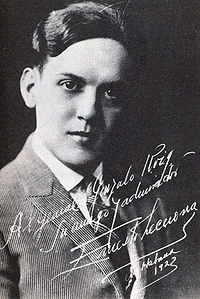Ernesto Lecuona Free Sheet Music Download
- Born 6 August 1895, Guanabacoa, Cuba
- Died 1963, Tenerife, Canary Islands
 Ernesto Lecuona is major, if not well-known, figure in popular music of this century. He brought the first successful Latin orchestra to the United States, fostered the careers of many of the most influential artists in Latin music, and composed many of its most enduring songs. He achieved the rare distinction of both popular and critical success, competing with the best of Tin Pan Alley as a songwriter while at the same time making his mark as a contemporary classical composer.
Ernesto Lecuona is major, if not well-known, figure in popular music of this century. He brought the first successful Latin orchestra to the United States, fostered the careers of many of the most influential artists in Latin music, and composed many of its most enduring songs. He achieved the rare distinction of both popular and critical success, competing with the best of Tin Pan Alley as a songwriter while at the same time making his mark as a contemporary classical composer.
The son of a newspaper editor, Lecuona was taught piano by his older sister, Ernestina. All of his siblings–two sisters and two brothers–were musicians, and he was a child prodigy, debuting at the age of five. He attended the National Conservatory in Havana and received his certificate at the age of 15. He studied with Ravel in Paris briefly, then played recitals in the U.S. His first major composition, “Malaguena,” was introduced by Lecuona at the Roxy Theatre in New York in 1927. “Andalucia,” published in 1930, was later reintroduced with English lyrics as “The Breeze and I” in 1940.
Following the success of Don Azpiazu’s Havana Casino Orchestra, the first major Latin group to perform in the U.S., Lecuona formed the Palau Brothers Cuban Orchestra, and later renamed it the Lecuona Cuban Boys. This group met with great success in the U.S. and Europe before disbanding the band in the mid 1930s and appeared in the early sound film, “Cuban Love Song.”
Lecuona wrote in virtually every form, from cantatas to piano pieces, but his songs are by far the best remembers works. BMI lists “The Breeze and I” as a having received over one million airplays. Among his other popular songs are “Dust on the Moon,” “Say Si Si,” “Jungle Drums,” “Always in My Heart,” “Siboney,” “La Comparsa,” and “Maria My Own (Maria O Lao).”
Lecuona was among the leading composers in early sound films, writing scores for numerous American and Latin American movies, including:
- “Under Cuban Skies,” MGM (1931)
- “Free Soul,” MGM (1931)
- “Susana Lenox,” MGM (1931)
- “Pearl Harbor,” MGM (unknown year)
- “La Cruz y La Espada” (The Cross and The Sword), MGM (unknown year)
- “Always in My Heart,” Warner Bros. (1942)
Title song was Oscar nominee for Best Song - “One More Tomorrow,” Warner Bros. (1946)
- “Carnival in Costa Rica,” 20th Century Fox (1947)
- “Maria La O” (Mexican film, unknown year)
- “Adios, Buenos Aires” (Argentine film, unknown year)
- “La Ultima Melodia” (Cuban film, unknown year)
Lecuona was named honorary cultural attache to the Cuban embassy in Washington in 1943 in recognition of his work as a cultural ambassador from Cuban. He performed only occasionally after that, though. One might say that he anticipated the percussion craze with his 1943 work, “Black Rhapsody,” which called for the orchestra to use “una quijada”–the jawbone of an ass.
Lecuona lived exclusively in ranches and farms in Cuba, raising small animals and exotic birds in his spare time. A lifelong bachelor, he pursued hobbies ranging from collecting antiques, cigarette lighters, and music boxes, reading Agatha Christie mysteries, following Cuban and American baseball leagues, and playing poker. He left Cuba for good in 1960 and vowed never to play again until Cuba was free from Castro and communism. He maintained residences in New York City and Tampa and Tallahassee, Florida. He died in the Canary Islands after traveling there to vacation and attend a concert in his honor. He was buried at the Gates of Heaven Cemetery in Long Island.
For more information, check out “Ernesto Lecuona: The Man Who Wrote Malaguena,
[wpsc_products category_url_name=’ernesto-lecuona’]
